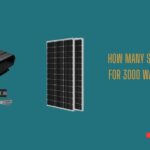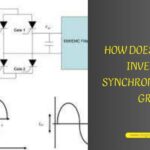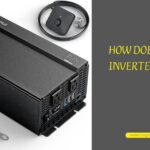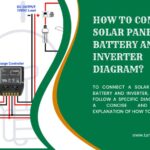How To Connect Solar Panel To Inverter Without Battery?
To connect a solar panel to an inverter without a battery, you can directly connect the panel’s output to the inverter’s input using an appropriate cable. Solar panels can be connected to inverters without the need for batteries by directly linking the panel’s output to the inverter’s input using a suitable cable.
This enables the conversion of the solar panel’s DC power into AC power for immediate use. By following this simple connection method, you can harness the energy from your solar panels without the expense or maintenance of a battery storage system.
Whether it’s for powering appliances, charging batteries, or feeding back excess energy into the grid, this direct connection provides a convenient and efficient way to utilize solar power.
Understanding Solar Panel To Inverter Connection Basics
When it comes to setting up a solar panel system, understanding how to connect the solar panel to an inverter is crucial. The solar panel-to-inverter connection is the heart of the system that allows the conversion of solar energy into usable AC electricity. In this article, we will delve into the basics of connecting a solar panel to an inverter without a battery, outlining the components required, the differences between connecting with and without a battery, and the advantages and disadvantages of connecting without a battery.
How to Connect Solar Panel to Inverter
Components Required For Connecting A Solar Panel To An Inverter
Before diving into the connection process, let’s first take a look at the essential components that you’ll need:
- A solar panel or multiple solar panels
- An inverter
- Dedicated solar panel cables
- MCP (Maximum Power Point) tracker (optional but recommended)
These components work together to ensure a smooth and efficient connection between the solar panel and the inverter. It’s crucial to choose high-quality components that are compatible with each other for optimal performance.
Differences Between Connecting With And Without A Battery
When connecting a solar panel to an inverter, there are two primary options: with a battery and without a battery. Let’s explore the key differences between these two approaches:
| Connecting with a Battery | Connecting without a Battery |
| Requires a battery to store excess energy | No battery is required |
| Relies on the direct utilization of solar energy | Relies on direct utilization of solar energy |
| Offers backup power during grid outages | No backup power during outages |
Understanding the differences between these two connection options is important in determining the most suitable approach for your specific needs and requirements.
Advantages And Disadvantages Of Connecting Without A Battery
Connecting a solar panel to an inverter without a battery offers its own set of advantages and disadvantages. Let’s take a closer look:
Advantages:
- Simplicity: The absence of a battery simplifies the system’s design and installation process.
- Cost-effective: Connecting without a battery can save you money on battery costs.
- Efficiency: Without the need to charge or discharge a battery, there is less energy loss in the system.
Disadvantages:
- No backup power: In the event of a grid outage, the system won’t provide backup power.
- Dependency on sunlight: Without a battery, the system can only generate and utilize solar energy when sunlight is available.
Understanding the advantages and disadvantages provides valuable insights for decision-making when it comes to connecting a solar panel to an inverter without a battery.
Step-by-step Guide To Connecting a Solar Panel To Inverter Without A Battery
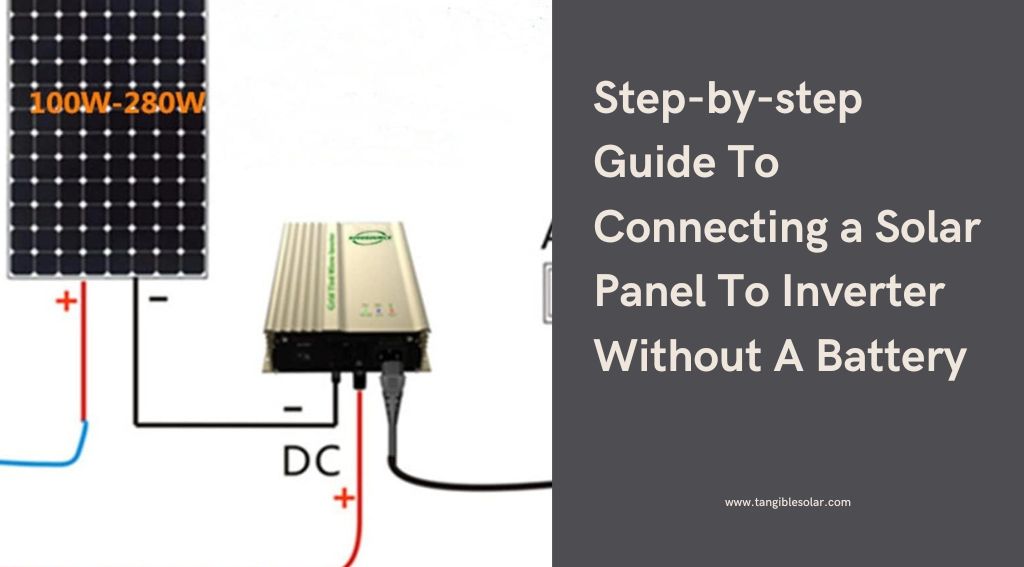
Welcome to our comprehensive guide on how to connect your solar panel to an inverter without the need for a battery! This step-by-step guide will walk you through the process, covering everything from selecting the right inverter to troubleshooting any potential issues. So let’s dive in and get your solar panel system up and running!
How to Connect Solar Panel to Battery And Inverter Diagram
Selecting The Appropriate Inverter For Your Solar Panel System
The first step to connecting your solar panel to an inverter is selecting the right inverter for your system. It’s crucial to pick an inverter that can turn the DC power your solar panel generates into AC power for use in your home or place of business and is compatible with the specifications of your panel.
When selecting an inverter, consider the following factors:
- The power output of your solar panel
- The voltage range of the solar panel
- The type of inverter (string inverter, microinverter, or power optimizer)
Ensure that the inverter you choose is capable of handling the power output and voltage range of your solar panel. The manufacturer’s specifications are usually where you can find this information.
Installing The Necessary Equipment For The Connection
Once you’ve selected the appropriate inverter, you’ll need to install the necessary equipment to establish the connection between the solar panel and the inverter. This may include:
- Mounting brackets or racks to securely install the solar panel
- DC cables and MC4 connectors to connect the solar panel to the inverter
- An AC disconnect switch to safely shut down the AC power
- Grounding equipment to ensure electrical safety
Follow the manufacturer’s instructions and local electrical codes when installing these components. Ensure that all connections are secure and properly insulated to prevent any electrical hazards.
Connecting The Solar Panel To The Inverter
Now that you have the necessary equipment in place, it’s time to connect your solar panel to the inverter. Follow these steps:
- Identify the positive (+) and negative (-) leads of your solar panel. These are usually marked on the back of the panel or in the user manual.
- Connect the positive (+) lead of the solar panel to the positive (+) terminal of the inverter.
- Connect the negative (-) lead of the solar panel to the negative (-) terminal of the inverter.
- Ensure that all connections are secure and properly tightened.
Once the connections are made, you can power the inverter and start generating AC power from your solar panel system.
Testing And Troubleshooting The Connection
After connecting the solar panel to the inverter, it’s essential to test the connection and troubleshoot any potential issues. Here are some steps to follow:
- Check the inverter’s display panel or app to ensure that it is receiving power from the solar panel.
- Monitor the AC output of the inverter to verify that it matches the expected power output.
- If the inverter is not functioning correctly, check the connections and ensure they are secure and properly insulated.
- If you encounter any issues during the testing process, consult the inverter’s user manual or contact a professional for assistance.
By following these steps, you can successfully connect your solar panel to an inverter without the need for a battery. Enjoy harnessing clean and renewable energy for your home or business!
Ensuring Safety And Efficiency In Solar Panel-to-Inverter Connection
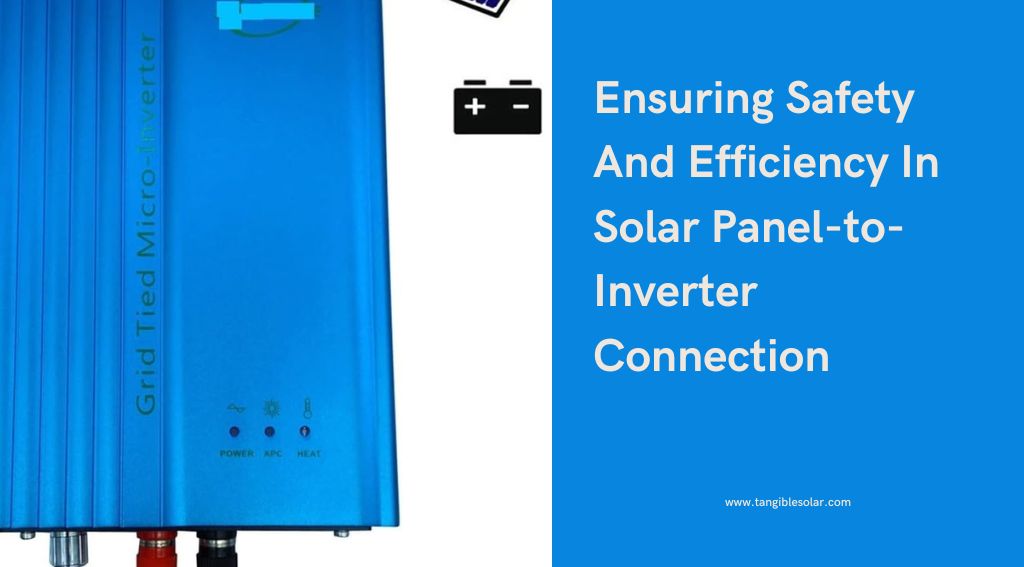
Ensuring safety and efficiency in the connection between solar panels and inverters is crucial for a successful solar energy system. Implementing the right measures and following best practices can help optimize performance while minimizing the risk of accidents. In this section, we will discuss the various aspects you need to consider when connecting solar panels to inverters without using batteries.
How to Connect Solar Inverter to WiFi
Grounding Requirements For The Solar Panel System
Proper grounding is essential for the safe and efficient operation of a solar panel system. Grounding helps prevent electrical shocks, protects equipment, and ensures compliance with electrical codes and regulations. When connecting your solar panels to the inverter, make sure to:
- Connect the grounding conductor of your solar panels to an electrical grounding point using appropriately sized grounding conductors.
- Implement a grounding electrode system, such as ground rods or grounding plates, for effective electrical grounding.
- Verify that all grounding connections are tight and secure to maintain consistent grounding throughout the system.
Using Appropriate Wiring And Connectors
Using the correct wiring and connectors is crucial for maintaining the efficiency and safety of your solar panel-to-inverter connection. Here’s what you need to consider:
- Choose wiring with an appropriate gauge and current-carrying capacity to minimize resistive losses.
- Use proper connectors that are compatible with the wire size and can withstand the outdoor environment.
- Ensure all connections are properly crimped or soldered to minimize voltage drops and potential failures.
Implementing Surge Protection Devices
Surge protection is essential to safeguarding your solar panel system from voltage spikes and transient surges caused by lightning strikes or grid disturbances. To enhance the protection of your inverter and solar panels, consider:
- Installing surge protection devices (SPDs) on both the AC and DC sides of your system to divert excessive voltage safely.
- Choose SPDs with the appropriate voltage ratings and follow the manufacturer’s instructions for installation.
- Regularly inspecting and maintaining the surge protection devices to ensure their continued effectiveness.
Optimizing The Connection For Maximum Efficiency
To maximize the efficiency of your solar panel-to-inverter connection, there are a few additional steps you can take:
- Minimize the length and routing of the wiring to reduce resistive losses and voltage drops.
- Ensure that all connections are clean and free from any dirt, corrosion, or loose fittings that can hinder efficient power transfer.
- Regularly inspect and clean your solar panels to ensure optimal sunlight absorption and performance.
- Monitor your system’s performance to identify any issues promptly and optimize its efficiency over time.
By following these guidelines for a safe and efficient solar panel-to-inverter connection, you can enhance the performance and longevity of your solar energy system. Remember to adhere to the specific manufacturer’s instructions and consult a professional if you are uncertain about any aspect of the connection process.
Monitoring And Maintaining The Solar Panel To Inverter Connection
Once you have successfully connected your solar panel to the inverter without a battery, it is crucial to ensure that the connection is functioning optimally. This means actively monitoring and maintaining the system to maximize its efficiency and longevity. In this section, we will discuss the importance of monitoring the solar panel’s output, the necessity of regular inspection and cleaning, troubleshooting common issues that may arise with the connection, and tips for upgrading and expanding your solar panel system.
Importance Of Monitoring Solar Panel Output
Monitoring the solar panel output is essential to ensuring that your system is generating the expected amount of electricity. It allows you to identify any performance issues, such as decreased power production, and take corrective measures promptly. Regular monitoring enables you to assess the efficiency of your solar panels and provides valuable data to evaluate their long-term performance.
Regular Inspection And Cleaning Of The Solar Panels
Regular inspection and cleaning of your solar panels are vital to maintaining their efficiency. Dirt, dust, and debris can accumulate on the panel’s surface, reducing its ability to capture sunlight effectively. Inspecting the panels allows you to identify any physical damage or obstructions that may hinder their optimal performance. To clean the solar panels, follow these steps:
- Switch off the solar panel system before starting the cleaning process.
- Gently remove any loose debris from the surface of the panels, using a soft brush or cloth.
- Prepare a solution of mild detergent and water, and wipe the panels with a clean, non-abrasive cloth.
- Rinse the panels thoroughly with clean water to remove any soap residue.
- Allow the panels to dry naturally before turning the system back on.
Troubleshooting Common Issues With The Connection
Even with proper installation, there may be times when you encounter issues with the connection between the solar panel and the inverter. Here are a few common problems and their potential solutions:
| Common Issue | Potential Solution |
| No Power Output | Check the connection between the solar panel and the inverter, ensuring it is secure and properly wired. Verify that the solar panel is receiving sufficient sunlight. |
| Intermittent Power Output | Inspect the wiring for loose connections. Check for any shading or obstructions that may affect the sunlight reaching the solar panel. |
| Low Power Output | Inspect the solar panel for dirt or debris that may be blocking sunlight. Check the angle and orientation of the panel to ensure maximum exposure to the sun. |
Upgrading And Expanding The Solar Panel System
If you wish to upgrade or expand your existing solar panel system, there are a few key considerations to keep in mind. Firstly, you need to ensure that your inverter has sufficient capacity to handle the increased load. Additionally, you may need to make adjustments to the wiring and electrical connections to accommodate the new panels. It is recommended to consult with a professional or an experienced installer to ensure a seamless and efficient expansion of your system.
Financing Options And Incentives For Solar Panel To Inverter Connection Without A Battery
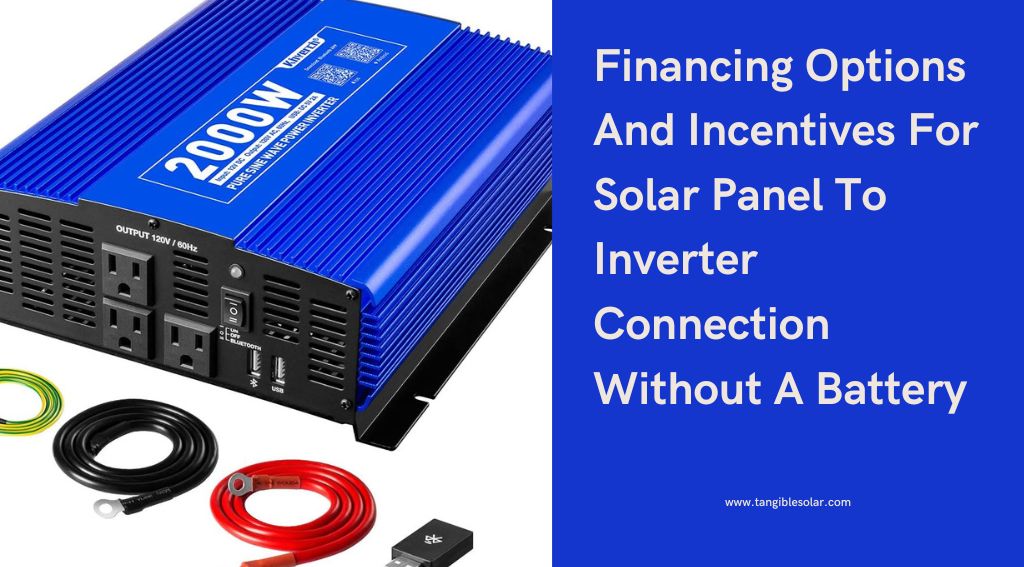
Investing in solar panels can significantly reduce your energy costs and environmental impact. While connecting solar panels to an inverter without a battery might seem like a complex process, the financial aspect doesn’t have to be. In fact, there are several financing options and incentives available that can make this renewable energy transition easier on your wallet.
Exploring Government Incentives And Rebates
One of the key ways to make your solar panel-to-inverter connection more affordable is by taking advantage of government incentives and rebates. Many countries and states offer various programs to encourage the adoption of solar energy. These incentives can come in the form of tax credits, grants, and rebates, making your upfront costs more manageable and helping to offset the installation expenses.
When it comes to government incentives and rebates, it’s essential to do your research and understand the eligibility criteria and application process. Consulting with a qualified solar energy professional can give you a clear understanding of the available programs in your area and how to maximize your savings.
Financing Options For Solar Panel Installation
If you don’t have the immediate funds to cover the cost of solar panel installation, there are various financing options you can consider. These options allow you to spread out the payments over time, making the investment more affordable in the short term.
One popular financing option is a solar loan. This type of loan is specifically designed for solar projects and offers competitive interest rates and flexible repayment terms. With a solar loan, you can finance the installation costs and start enjoying the benefits of solar energy while making monthly payments.
Another financing option is a power purchase agreement (PPA), where a solar company installs and maintains the panels on your property. In exchange, you consent to pay a set price for the electricity the panels produce. This option eliminates the upfront costs entirely and allows you to pay for solar energy on a monthly basis.
Calculating The Return On Investment
When considering the financial aspect of connecting solar panels to an inverter without a battery, calculating the return on investment (ROI) is crucial. The ROI helps you determine the break-even point when the savings from your solar energy production outweigh the initial costs.
To calculate the ROI, you need to consider factors such as the cost of the solar panel system, installation costs, energy savings over time, and any applicable incentives and rebates. By analyzing this data, you can estimate how long it will take to recoup your investment and determine whether it’s a financially viable decision.
Keep in mind that the ROI calculation is unique to each situation, and consulting with a solar energy professional can provide you with accurate and personalized estimates.
Exploring Alternative Funding Sources
If traditional financing options are not feasible for your solar panel-to-inverter connection, there are alternative funding sources worth exploring. Some homeowners turn to crowdfunding platforms or community solar programs, where multiple participants pool their resources to invest in a shared solar project.
Additionally, some financial institutions offer specialized green energy loans or energy efficiency mortgages that can assist in funding solar panel installations.
Before considering alternative funding sources, it’s essential to evaluate their terms and conditions, including interest rates, repayment periods, and any potential risks. Working with a solar energy professional can help you identify the best alternative funding options available to you.
FAQs: How To Connect Solar Panel To Inverter Without Battery
How Does a Batteryless Inverter Work?
A batteryless inverter operates by converting DC power from solar panels directly into AC power for your home without using batteries. It does this by using advanced electronics to efficiently convert the power and regulate the voltage for immediate use.
How To Connect a Solar Panel to a Battery Without a Charge Controller
To connect a solar panel to a battery without a charge controller, make sure the panel’s voltage doesn’t exceed the battery’s. Connect the positive terminal of the panel directly to the positive terminal of the battery, and the negative terminal of the panel to the negative terminal of the battery.
Done.
How Can I Connect a Solar Panel to an Inverter Without Using a Battery?
To connect a solar panel to an inverter without using a battery, you need a grid-tie inverter or a microinverter. These devices directly convert the DC power generated by the solar panel into AC power that can be used or fed back into the grid.
By bypassing the need for a battery, you can save on costs and simplify your solar power system installation.
What Are the Advantages of Connecting a Solar Panel to an Inverter Without a Battery?
Connecting a solar panel to an inverter without using a battery offers several advantages. Firstly, it eliminates the need for maintenance and replacement of batteries, reducing costs in the long run. Additionally, without a battery, the system can be more efficient as there are no energy losses during charging and discharging.
Lastly, it simplifies the installation process and reduces the overall system size.
Conclusion
To sum up, connecting a solar panel to an inverter without a battery is a simple and effective way to harness solar energy. By following the step-by-step process outlined in this blog post, you can make the most of your solar panel system and enjoy the benefits of clean, renewable energy.
Remember to ensure proper safety measures and consult a professional if needed. Embrace the power of solar energy and contribute to a greener future.

